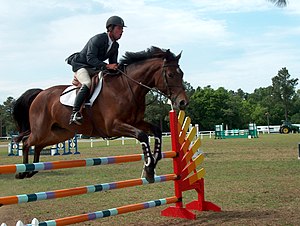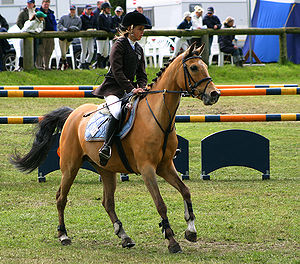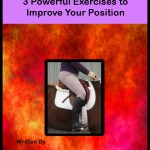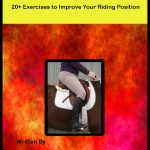Do you Chip? Fix that chip in 30 minutes with these proven exercises

Chipping in can ruin an otherwise excellent round. With everything moving quickly your horse may move past his perfect distance and ‘chip in’ that last stride.
In a class of seasoned competitors a ‘chip’ may not be in the ribbons and could cost you the class.
We have all seen them. Beautiful rounds ruined to mediocrity by a bad spot or chip.
Where it starts
Chipping begins with the rider. And as a seasoned Senior judge (jumper and hunter) who sees a lot of horses I think it comes from 2 areas:
- Riders riding forward and changing the stride length in front of the fence.
- Riders leaning forward without leg backup not allowing the horse to leave the ground.
Changing Pace In Front of the Jump
An otherwise perfect take off spot can be destroyed with an over zealous rider. If you increase the stride on the approach to the fence you will ride past your distance resulting in a chip.
This has been proven again and again and can be seen when riders come around their turn toward a jump and continue to ride forward and allow the horse to lengthen its stride. There is a difference between riding forward and allowing your horse’s stride to get longer.
Anatomy of a Chip
This can be seen when a horse is a perfect 4 12-foot strides away and the rider continues to drive the horse and allow the horse’s stride to get longer with each stride. This leaves the horse no alternative but to either launch a stride too early or be safe and ‘chip in’.
When a horse does 4 even stride lengths, the horse does:
1 12 foot stride
1 12 foot stride
1 12 foot stride
1 12 foot stride
leaving 6 feet for take off and 6 feet for landing in a 60 foot distance between two fences.

When a horse increases his stride length with each stride, rather than doing 4 even 12 foot strides does:
1 12 foot stride
1 13 foot stride
1 14 foot stride
1 14 foot stride
This leaves 6 feet for landing and then leaves only 1 foot for take off. This is the chip.
Riders Leaning Forward to Chip
The other chip option comes from riders which, rather than sit up and allow their horses to leave the ground, have ‘loaded’ their horses front end by leaning TOO FAR FORWARD. This seems to be more common in the last few years.

If you are hunching and rounding your shoulders or leaning onto the horses neck, you will prevent the horse from rocking back onto his hindquarters and lifting his body off of the ground. When you lean forward your centre of gravity is ahead of the horse’s centre of gravity. This weighs down his forehand and makes the horse quick in front of his fences as the horse tries to ‘catch up with you’.
Often what happens when riders are leaning too far forward without the correct leg back up, is the horse is un-able to get to the jump in the correct distance. As a result an ‘add chip’ happens because the rider has no leg back up, and is leaning on the horse’s front end making it difficult for the horse to lift his front end in good form.
Proven Exercises to Correct a Chip
Exercise One
This exercises helps riders develop a sense of stride length and stride control. This is simply repeated riding over a correctly set up 4 stride line of 2 fences.
Set up 2 jumps the standard 60 feet distance (if you are riding a pony or small horse adjust your distance to 55 feet between fences) and approach at the canter. Keep yourself in balance and ride the correct number of strides between the two fences.
The horse will:
- land
- do 4 even strides
- take off
This simple exercise can help:
- educate the horses eye to the correct stride
- educate the rider’s eye to the correct striding
When they land from the first jump they know they have 4 strides before take off. Riders can count – landing, 1, 2, 3, 4, to help them if they like.
The landing should take place approximately 5 – 6 feet out from the base of the first fence and leaves the correct amount of distance for the strides. If your horse jumps too far into the line, it will make the useable distance between the fences shorter and you will have to ride differently. – more on this later.
Stride 1 is your recovery stride. Get your position back, organized and ready to move on. This is not a holiday place and don’t stay here. Get your bearings and move on. Assess in one stride and keep going.
Stride 2 should be finished about 1/2 way between the two fences. This is where decisions are made. If you are:
- lacking forward energy sit up and leg on
- too forward, sit up, leg on and hold
- drifting, sit up and leg on
Stride 3 should start 1/2 way between the two fences. Stride 3 is where the average rider knows if they will get the correct distance or not.
Stride 4 is the last stride before the fence and the only option is to keep your leg on and ride the fence as it is coming to you. If you haven’t ridden stride 1 or 2, you will not be able to correct anything on stride 4.
Exercise Two
Set out 4 rails on the ground approximately 10 feet apart. Pick up a balanced canter and canter through the centre of each rail. This will help teach riders how to ride the same stride length each stride.
The horse will ‘jump’ each rail and this will permit riders to understand how to regulate the horses stride.
What exercises to you use to help you with your stride control?



 Try these three powerful exercises to get strengthen your position.
Try these three powerful exercises to get strengthen your position.
